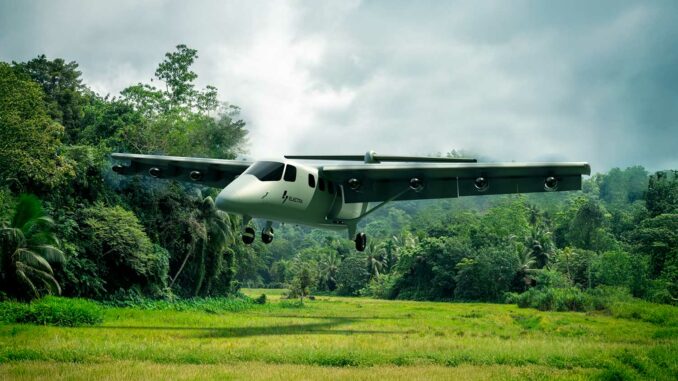
Skunk Works and Electra are teaming up to develop the EL9, a hybrid ultra-short takeoff aircraft for military and civilian use.
Lockheed Martin, through its Skunk Works division, is teaming up with US start-up Electra to develop the EL9, a hybrid-electric ultra-short takeoff and landing (Ultra-STOL) aircraft designed for military and civilian missions on unprepared terrain. The partnership aims to accelerate the design, industrialization, and integration of the aircraft into real operational scenarios, with a range of 1,600 km, a payload capacity of 450 kg, and runway requirements limited to 45 meters. The challenge is to offer a versatile alternative to conventional helicopters and aircraft, with reduced operating costs, a low thermal and noise footprint, and high logistical autonomy. This initiative is in line with the US military’s priorities for mobile, lightweight and resilient platforms for decentralized conflicts.
Technical cooperation between Skunk Works and Electra
The signing of the memorandum of understanding (MoU) formalizes the collaboration between Electra, an emerging company specializing in hybrid electric technology, and Skunk Works, the experimental arm of Lockheed Martin, historically known for its work on the U-2, F-117 and SR-71. This cooperation goes beyond simple industrial support: it structures the entire EL9 development chain.
The agreement provides for synergy in five strategic areas:
- Digital engineering
- Advanced manufacturing methods
- Supply chain strategy
- Long-term logistical support
- International deployment and marketing
Skunk Works brings recognized expertise in aircraft design for complex environments, including thermal and acoustic stealth requirements and resilience in harsh terrain. At the same time, Electra is capitalizing on its expertise in hybrid-electric propulsion, which has already been validated in ground tests with small-power turbogenerators.
This partnership also aims to integrate the EL9 into future Pentagon operational concepts, particularly for autonomous tactical missions, supply to isolated areas, and rapid evacuations.
The relationship between the two entities dates back to 2022, when Lockheed Martin Ventures invested in Electra through a strategic cooperation agreement. The current framework represents an expansion and formalization of this technical relationship.
The EL9: an ultra-light tactical hybrid aircraft
The EL9 is distinguished by a series of technical features specific to the needs of the armed forces:
- Takeoff/landing in 45 meters, the length of a football field
- 450 kg payload capacity, equivalent to a logistics pallet or two fully equipped personnel
- 1,600 km range, equivalent to Paris–Palma de Mallorca without refueling
- Reduced thermal and noise footprint, thanks to a partially electric hybrid propulsion system
- Capable of operating from unpaved or uneven runways
In terms of energy, the system is based on a thermal turbogenerator that produces electricity for electric propeller engines. This architecture guarantees greater autonomy than purely electric aircraft, while maintaining a significant reduction in cost per flight hour, estimated at less than $500, compared to $1,500 to $2,000 for a light helicopter.
The EL9 could be used for:
- Last-line logistical resupply to isolated bases
- Discreet intelligence or liaison missions
- Rapid medical evacuations in degraded environments
- Deploying microsensors, communication relays, or autonomous units
These characteristics position it as an alternative to UH-72 Lakota helicopters, MQ-1 drones, or light STOL aircraft such as the C-145A.

A response to current military needs
The EL9 is in line with the decentralized mobility doctrines developed by the US armed forces, particularly in areas of denied access, such as the Pacific or sub-Saharan Africa. The ability to operate without a prepared runway, with little logistical support, represents a break with traditional systems.
This type of lightweight, modular platform offers several advantages:
- Reduced strategic risk: by spreading air assets across dozens of micro-bases, the impact of a single strike is limited
- Logistical resilience: a hybrid aircraft such as the EL9 requires less fuel and can operate with reduced maintenance units
- Tactical flexibility: it allows for one-off missions without mobilizing an entire squadron
In a context where special forces are playing an increasingly important role, an aircraft such as the EL9 allows for discreet insertions and extractions, with a lower radar, thermal, and acoustic signature than a helicopter. It could also integrate new-generation ISR (Intelligence, Surveillance, Reconnaissance) sensors, such as compact AESA radars or gyrostabilized optronic systems.
The acquisition cost is another argument in its favor: estimated at around $5 to $6 million per unit, the EL9 could allow 20 to 25 aircraft to be purchased for the price of a single V-280 Valor. This offers an economical solution for US partner countries, including in security assistance or anti-trafficking programs.
Industrial prospects and geopolitical challenges
The partnership between Lockheed Martin and Electra is part of a broader drive toward technological diversification in response to the growing complexity of asymmetric conflicts. Standardization around the F-35 or KC-46 is showing its limits in the event of distributed conflicts or fragmentation of theaters of operations.
This project also allows Lockheed Martin to test dual-use technologies, both civil and military, while expanding its aerospace portfolio beyond traditional channels. The use of a more agile company such as Electra facilitates the rapid introduction of prototypes onto the market, with development cycles reduced to two or three years, compared with seven to ten years for conventional programs.
From a geopolitical perspective, the introduction of an EL9 aircraft could support humanitarian logistics and United Nations or USAID operations, as well as strengthening the US presence in regions not covered by standard airports.
Finally, the integration of the program into the budgets of the Defense Innovation Unit (DIU) or SOCOM (Special Operations Command) could be a fast track to operational acceptance of the model.
War Wings Daily is an independant magazine.